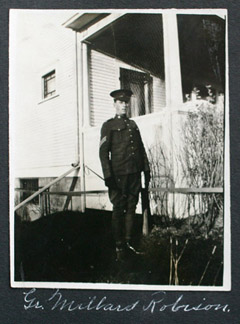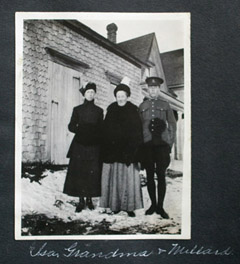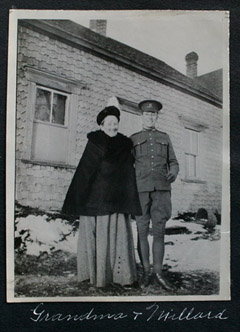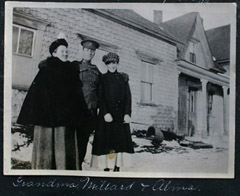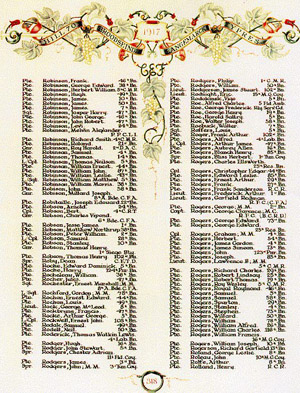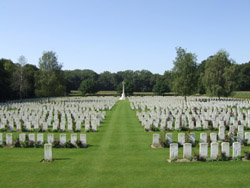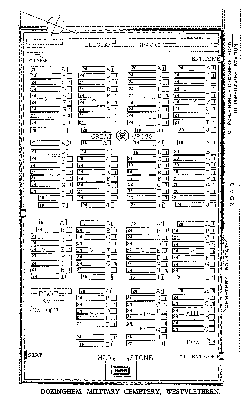

In memory of
Gunner
MILLARD JOSEPH ROBISON
Service Number: 1251032
April 16, 1897 - November 19, 1917
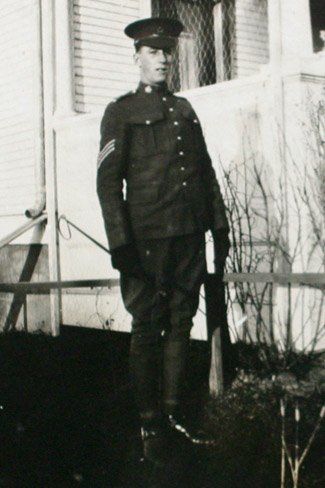
Medium sized pop up image
649 X 974, 72 dpi, 262 kFull sized pop up image
649 X 974, 180 dpi, 536 kCropped version of phototraph to left below taken some time in early 1915 of Gunner Millard Robison between time of enlistment and deployment overseas. Millard is standing in front of what his nephew Al Robison describes as what "we always knew as Aunt Alma's house, on 6th Avenue A, but which was in fact the first house our Grandpa Robison had built in Lethbridge. He and Grandma and most of the kids presumably lived there until he built the house at 2004 Seventh Avenue South. Source: Tim Patterson, 7 Aug 2008 from the Robison Family photograph collections at Campburn Farm, Harvey Station, York County, New Brunswick.
Medium sized pop up image
700 X 945, 72 dpi, 272 k
Full sized pop up image
1240 X 1674, 180 dpi, 1400 k
Medium sized pop up image
700 X 771, 72 dpi, 244 k
Full sized pop up image
1567 X 1726, 180 dpi, 1700 k
Medium sized pop up image
700 X 968, 72 dpi, 288 k
Full sized pop up image
1245 X 1722, 180 dpi, 1700 k
Medium sized pop up image
700 X 573, 72 dpi, 216 k
Full sized pop up image
1562 X 1278, 180 dpi, 1300 kThe three images of Millard wtih people in them were taken at Campburn Farm in Harvey with his Grandma Robison (nee Eleanor "Jane" Herbert). Millard's nephew Al Robison vividly remembers "Uncle Albert -- our Grandpa Robison's younger brother -- telling me when I met him in Harvey on my first visit there about the joyful celebration they all had down at the train station when Norman and Millard came though on their way to Halifax to board the ship for England. Their idea was to go over there and give the Huns "a good kick in the ass" and then be back in time for Christmas. That was apparently a common view throughout Canada in 1915, that the troops would be home by Christmas." Source: Tim Patterson, 7 Aug 2008 from the Robison Family photograph collections at Campburn Farm, Harvey Station, York County, New Brunswick.
Military Service
Service Number: 1251032Age: 21
Force: Army
Unit: Canadian Field ArtilleryDivision: 8th Bde.
Commemorated on Page 318 of the First World War Book of Remembrance.
Medium sized pop-up image
528 X 692, 96 dpi, 171 k
Additional Information:
Gunner Millard Robison, was the son of George Robison and Margaret "Maggie" Embleton. The family moved to Aerta in 1911, altough all of their children were born in Harvey. Millard Roblson was born 16 Apr, 1897, moved to Lethbridge, Alberta with his family when he was 14, and died 19 Nov 1917, WWI, just after the Battle of Passchendaele (12 Oct 1917 - 10 Nov 1917), Belgium.Cemetery:
Dozinghem Military Cemetery, Belgium.Location:
Dozinghem Military Cemetery, Belgium. is located 12 Km west of Ieper town centre on the Leeuwerikstraat, a road leading from the N308 connecting Ieper to Poperinge. From Ieper town centre the Poperingseweg (N308), is reached via Elverdingsestraat then directly over two small roundabouts in the J. Capronstraat. The Poperingseweg is a continuation of the J. Capronstraat and begins after a prominent railway level crossing. On reaching the town of Poperinge the right hand turning onto the R33 Oostlaan leads to the left hand junction with Veurnestraat. The Veurnestraat leads to the first right hand turning onto the Sint Bertinusstraat. The third right hand junction along this road leads onto Krombeekseweg, towards the village of Krombeke. 3.5 Km along this road which at this point is known as Leeuwerikstraat, lies the signpost indicating the right hand turning onto a woodland track leading to Dozinghem Military Cemetery, Belgium.. The cemetery is located a short distance along the track.Westvleteren was outside the front held by Commonwealth forces in Belgium during the First World War, but in July 1917, in readiness for the forthcoming offensive, groups of casualty clearing stations were placed at three positions called by the troops Mendinghem, Dozinghem and Bandaghem. The 4th, 47th and 61st Casualty Clearing Stations were posted at Dozinghem and the military cemetery was used by them until early in 1918. There are now 3,174 Commonwealth burials of the First World War in the cemetery and 65 German war graves from this period. The cemetery also contains 73 Second World War burials dating from the Allied withdrawal to Dunkirk in May 1940. The cemetery was designed by Sir Reginald Blomfield.
Casualty Details: UK 3058; Canada 61; Newfoundland 19; Australia 6; New Zealand 14; South Africa 15; Germany 65; Total Burials: 3239
Grave Reference:
XIV. C. 10.
Dozinghem Military Cemetery
Medium sized pop-up image
640 X 480, 72 dpi, 76 kDozinghem Cemetery Plan
Medium sized pop-up image
500 X 807, 72 dpi, 19 kThe 1917 Battle of Passchendaele, also known as the Third Battle of Ypres or simply Third Ypres, was one of the major battles of World War I, fought by British, ANZAC and Canadian soldiers against the German Army. The battle was fought for control of the village of Passendale, (Passchendaele on maps of that time), near the Belgian town of Ypres in West Flanders. The plan was to drive a hole in the German lines and advance to the Belgian coast and capture the German submarine bases there. It would have created a decisive corridor to be opened in a crucial area of the front, and it would also take pressure off the French forces. After the disastrous Nivelle offensive, the French Army was suffering from extremely low morale, which resulted in such an increase in cases of mutiny and misconduct as to threaten the field-worthiness of entire divisions.
The land on which the battle took place was largely reclaimed marshland, swampy even without rain. The extremely heavy preparatory bombardment by the British tore up the surface of the land, and heavy rain from August onwards produced an impassable terrain of deep "liquid mud", in which an unknown number of soldiers drowned. Even the newly-developed tanks bogged down. The Germans were well entrenched, with mutually-supporting pillboxes which the initial bombardment had not destroyed. The town of Passendale was finally taken by the Canadian forces, but the combined casualties of the allies was almost a half of a million men, with about a quarter million men lost by the Germans.
Passendale is the modern Dutch spelling of the village, and the old name of Passchendaele is now used only to refer to this battle and by locals who pronounce it in West Flemisch dialect. This term should properly apply only to the later actions of the battle in October–November 1917, but has come to be applied also to the entire campaign from July 31. After three months of fierce fighting, the Canadian Corps took Passchendaele on November 6 1917, ending the battle. In the history of World War I, the term 'Passchendaele' has become a symbol of the extreme brutality of industrial warfare.
First Battle of Passchendaele
The First Battle of Passchendaele, on October 12 1917 began with a further Allied attempt to gain ground around Poelkapelle. The heavy rain again made movement difficult, and artillery could not be brought closer to the front owing to the mud. The Allied troops were tired, and morale was suffering. Against the well-prepared German defences, the gains were minimal and there were 13,000 Allied casualties.
By this point in the battle there had already been 100,000 Allied casualties, with only limited gains and no strategic breakthrough.
Second Battle of Passchendaele
At this juncture two divisions of the Canadian Corps were moved into the line to replace the badly depleted ANZAC forces. After their successes at Vimy Ridge and the Battle of Hill 70, the Canadians were considered to be an élite force and were sent into action in some of the worst conditions of the war.
Upon his arrival, the Canadian Commander-in-Chief General Sir Arthur Currie expressed the view that the cost of the objective would be sixteen thousand casualties. While Currie viewed this figure as inordinately high in comparison to the value of the objective, Haig was conditioned to accept high casualty rates after years of allied losses in the hundreds of thousands. He therefore ordered the offensive to proceed over Currie's objections.
The Canadians moved into the line during mid-October, and on October 26 1917, the Second Battle of Passchendaele began with twenty thousand men of the Third and Fourth Canadian Divisions advancing up the hills of the salient. It cost the Allies twelve thousand casualties for a gain of a few hundred yards.
Reinforced with the addition of two British divisions, a second offensive on October 30 resulted in the capture of the town in blinding rain. For the next five days the force held the town in the face of repeated German shelling and counter-attacks, and by the time a second group of reinforcements arrived on November 6, four-fifths of two Canadian divisions had been lost.
Their replacements were the Canadian First and Second Divisions. German troops still ringed the area, so a limited attack on the 6th by the remaining troops of the Third Division allowed the First Division to make major advances and gain strong points throughout the area.
One such action on the First Division front was at Hill 52; the Tenth Battalion, CEF were called out of reserve to assist an attack on Hill 52, part of the same low rise Passchendaele itself was situated on. The Battalion was not scheduled to attack, but the Commanding Officer of the Tenth had wisely prepared his soldiers as if they would be making the main assault – a decision that paid dividends when the unit was called out of reserve. On 10 November 1917, the Tenth Battalion took the feature with light casualties.
A further attack by the Second Division the same day pushed the Germans from the slopes to the east of the town. The high ground was now firmly under Allied control. Although the major activity associated with Passchendaele ended by 10 November 1917 the Canadian Field Artillery continued harrassing fire on the German Army. Gunner Millard Joseph Robison died on 19 November most likely due to counter battery activity, or from an accident.
Source:
Veterans Affairs CanadaEntry last updated 11 September 2008
Please contact Tim Patterson (tim.patterson@carleton.ca)
to provide additional data, or to correct any errors.
